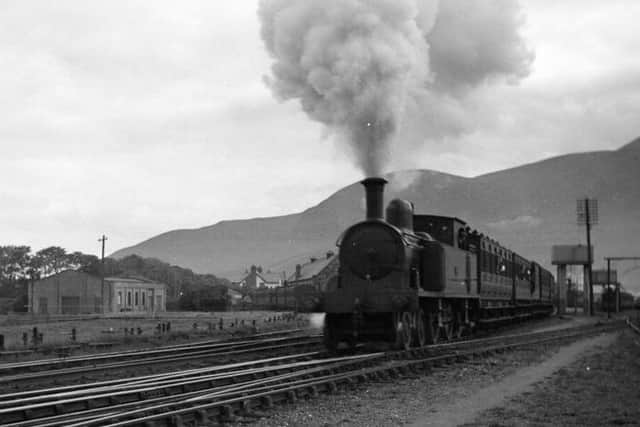Comber to Belfast journey still not bettered 70 years down line


Lamenting the 70 years that have passed since a large part of the Belfast and County Down Railway closed, a vintage train enthusiast has said that despite subsequent investments in public transport nothing has come close to matching the 15 minutes it used to take to get from Comber to Queen’s Quay by rail.
Robert Gardiner, chairman of the Downpatrick and County Down Railway heritage group, said that if the railway had still existed it would form a vital transport link from the commuter belt to the east of Belfast into the capital.
Advertisement
Hide AdAdvertisement
Hide AdOn the morning of January 15, 1950, train travel on the Belfast and County Down Railway (BCDR) ceased.


It marked the end of 100 years of railway transport in east Down where trains would have served Castlewellan, Newcastle, Ballygowan, Saintfield, Ballynahinch, Crossgar, Dundrum, Downpatrick and Ardglass.
Later that year – on April 22, 1950 – services from Belfast to Comber where the train would make stops at Bloomfield, Neill’s Hill, Knock, Dundonald and on to Donaghadee also ceased.
Robert, who is chair of the heritage railway set up on the former Downpatrick BCDR terminus, said: “It seems incredible today to think that such a vital transport link could be easily discarded, but in 1950 the ministers in the devolved Stormont government took the view that railways were as obsolete as the stagecoach.
Advertisement
Hide AdAdvertisement
Hide Ad“In a way, they were right that the lines were Edwardian relics – and the BCDR in particular still operated obsolete Victorian carriages – but investment since then in new technologies in track, signalling and rolling stock over those years have showed what we could have had throughout Northern Ireland.
“But even then, in 1948 an express train from Comber to Belfast could get you into the old Queen’s Quay station near the Odyssey arena in 15 minutes – despite the investment in the Glider and other public transport initiatives nothing has come close to replicating that speed and efficiency.”
Up to the 1940s, the main railway network in NI was operated by three companies: the London Midland and Scottish (LMS) Railway’s ‘Northern Counties’ lines, operating out of York Road to Larne and Londonderry; the Great Northern Railway, departing from Great Victoria Street to places like Dungannon and Armagh, as well as Dublin; and the Belfast and County Down Railway, based at Queen’s Quay.
In 1948, the Stormont government decided to nationalise the network and amalgamate the LMS and BCDR with bus operator, the Northern Ireland Road Transport Board, to form the Ulster Transport Authority, a predecessor to Translink.
Advertisement
Hide AdAdvertisement
Hide AdMr Gardiner said: “A tribunal was set up to consider how this could be best achieved and provide an integrated transport system.
“Rail chiefs, who had been hoping for investment after the railways had proved so crucial to the war effort a few years earlier and that the buses would be barred from competing with the trains and instead provide a feeder service to stations, were devastated at the outcome.
“The recommendation, accepted by Stormont, was that the entire BCDR main line from Belfast to Newcastle, including the branches to Donaghadee, Ballynahinch and Ardglass, should be closed.”
The only route to be saved was the Belfast to Bangor connection, which still operates.
Advertisement
Hide AdAdvertisement
Hide AdMr Gardiner said: “The attitude of Stormont was that it would be cheaper to move everything to the roads than to invest in railways that had been run down during the Second World War – people would use the buses instead.
“They developed huge road building schemes – most were never completed – but closed the railways first before these were even started.”
He added: “The most puzzling element of the decision was the axing of the Belfast to Newtownards line, which served the east of the city, where the suburbs were developing and likely to provide increased commuter traffic.
“Indeed, there were more than enough new diesel trains ordered to operate both the Bangor and Newtownards lines – and evidence suggests that the Transport Tribunal expected Stormont to spare the Comber line as a compromise option.
Advertisement
Hide AdAdvertisement
Hide Ad“As late as 1953 before the tracks were lifted they were calling on the minister responsible to reverse the decision and trial these new diesel trains on this section of track – a call that fell on deaf ears.”
Willie Watterson and James Magill, who worked at Newcastle and Tullymurry stations, recalled their memories of the last train in an interview recorded for the BBC documentary ‘Raising Steam’ in 2007.
Willie said: “The last train was a Sunday night. It was a cold winter night.
“There was 12 coaches, and two engines and two guards. She was packed. Packed to the doors.
Advertisement
Hide AdAdvertisement
Hide Ad“So I lit all the lamps, and put detonators on the line to give her a send-off.”
James added: “I think every station did the same thing, so when the train came in there was a salute of bangs. I felt terrible about it, terribly terribly sad. I still felt it couldn’t happen. Still felt they’ll come back, they’ll run again.
“I couldn’t believe there’d be no more railways, after working on them so hard.”